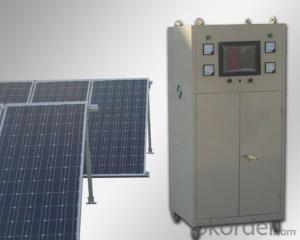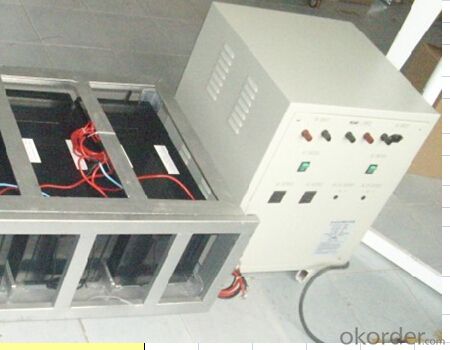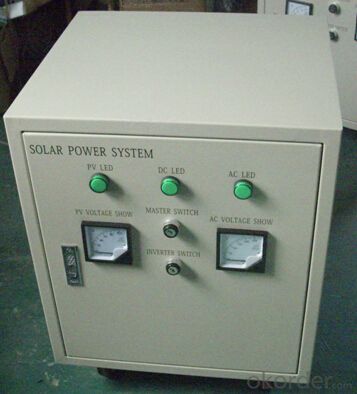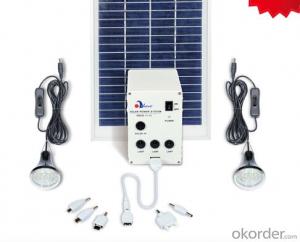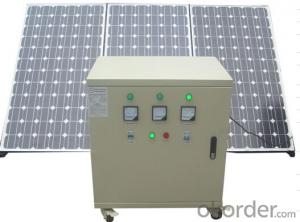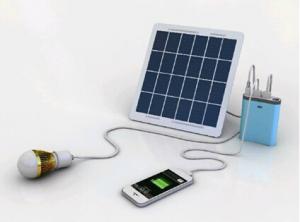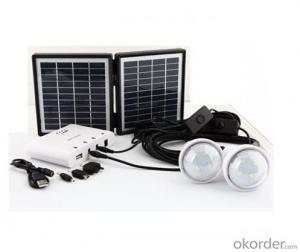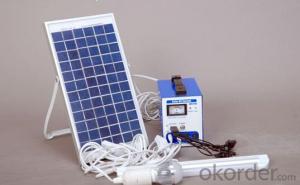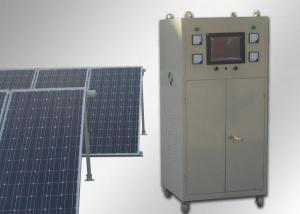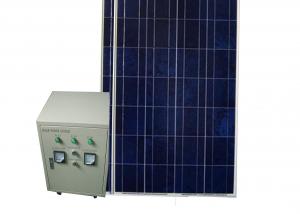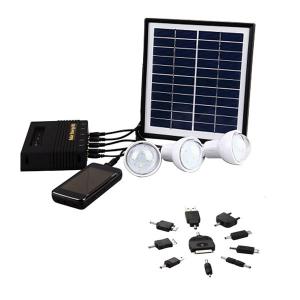Arc Solar Energy Systems CNBM 5000W Solar Home System Roof System Solar Energy
- Loading Port:
- Shanghai
- Payment Terms:
- TT or LC
- Min Order Qty:
- 1 pc
- Supply Capability:
- 30000 pc/month
OKorder Service Pledge
OKorder Financial Service
You Might Also Like
Working Principle of Solar Home System
The stand alone Solar Home System is an off-grid solar system which uses batteries to store the solar energy. Stand alone solar system solutions design for those who are not able or willing to connect to electricity grid.
However, our on-grid solar home system can be connected to the grid for utilization of grid electricity power. Our solar system can add relative equipment as our customer’s requirement which have the function of switching to city electricity automatically. The solar system can use battery power in priority, if sunshine is not so good or loads consumption is too high which cause battery power insufficient. Then system can switch automatically to grid power supply. Meanwhile, the system can charge the batteries with grid power until batteries are fully charged. Then the solar system will switch back to battery power supply.
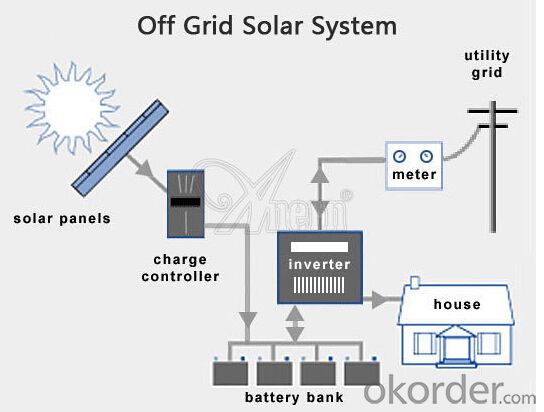
Product Details of Solar Home System
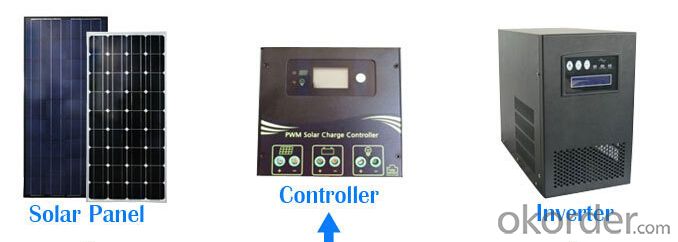
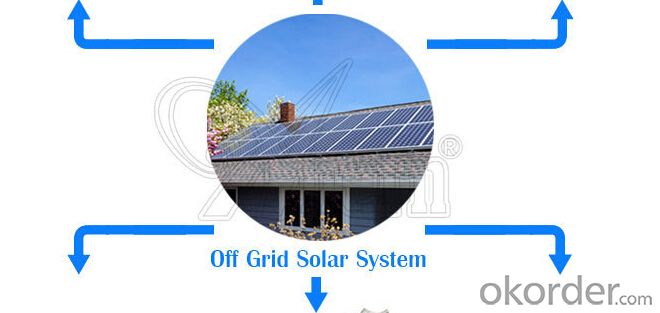

Specification of Solar Home System
Technical data: | ||||||||
Inverter | Rated load power | 5000W | ||||||
Output wave | Pure sine wave | |||||||
Input voltage | 110V | |||||||
Output voltage | DC:12V | |||||||
Output frequency | 50HZ/60HZ | |||||||
Precision of output frequency | ±6% | |||||||
Solar panel | Pmax | 180W*28PCS | ||||||
Vmp | 36V*4*7 | |||||||
Imp | 52.5A | |||||||
Charger controller | Charger voltage & current | 110V/60A | ||||||
Battery | Capacity | 12V/150AH*16PCS | ||||||
support | Aluminium | 4PCS/SET*7 | ||||||
Power box | Spray paint iron box,with input,output, ammeter,voltmeter,master switch and so on. | |||||||
Package data: | ||||||||
Part | Size (L*W*H mm) | Weight (kg) | 20' (pcs) | 40' (pcs) | ||||
Power box | 840*620*150 | 140 |
|
| ||||
Solar panel | 1610*830*100*(6ctns) | 180 | ||||||
Battery | 1100*520*650*2 | 1200 | ||||||
Loading electrical equipment(For consulting) | ||||||||
Name of Load | Power(W) | Quantity | Working Time per Day (H) | Working Days | ||||
Color TV | 65W | 2 | 6 | 3 days | ||||
Satellite TV Receivers | 25W | 2 | 6 | 3 days | ||||
lamp | 11W | 8 | 8 | 3 days | ||||
Computer | 150 W | 2 | 6 | 3 days | ||||
FAN | 60W | 4 | 6 | 3 days | ||||
Other | 3000W | 1 | 6 | 3 days | ||||
Advantage of Our Solar Home System
1 Excellent Performance: Our Solar Home System is composed by Brand Standard Kits with high quality. Our solar system has the advantage of high efficiency and stable operation. We can ensure our product with a long life period.
2. Small Orders Accepted: We can accept small orders as our customer’s trial order.
3. Warehouse: We have warehouse overseas which can bring great convenience to our customer to pick up the products.
- Q: What are the environmental impacts of solar energy systems?
- Solar energy systems have several positive environmental impacts. Firstly, they produce clean and renewable energy, reducing the reliance on fossil fuels and decreasing greenhouse gas emissions. Additionally, solar panels do not emit any pollutants during operation, contributing to improved air quality. However, the manufacturing process of solar panels can have some environmental impacts, including the use of certain materials and energy-intensive production. Nevertheless, when considering the entire lifecycle of solar energy systems, the environmental benefits far outweigh the potential drawbacks.
- Q: What are the components of a solar energy system?
- A solar energy system consists of several key components that work together to harness the power of the sun and convert it into usable electricity. The main components of a solar energy system include: 1. Solar Panels: These are the most recognizable element of a solar energy system. Solar panels, also known as photovoltaic (PV) panels, are made up of multiple solar cells that convert sunlight into direct current (DC) electricity. They are typically mounted on the roof or ground to capture sunlight. 2. Inverter: The DC electricity generated by the solar panels needs to be converted into alternating current (AC) electricity, which is the type of electricity used in homes and businesses. An inverter is responsible for this conversion process, ensuring that the electricity can be used by various appliances and devices. 3. Mounting System: Solar panels need to be securely mounted on rooftops or on the ground. The mounting system consists of racking or frames that hold the panels in place and allow for optimal sunlight exposure. The mounting system also ensures that the panels are installed at the correct angle and orientation to maximize energy production. 4. Electrical Wiring: Proper electrical wiring is crucial to connect the solar panels, inverter, and other components of the solar energy system. The wiring carries the electricity from the panels to the inverter, and then to the electrical panel of the building, where it can be distributed and used. 5. Batteries (Optional): In some solar energy systems, batteries are included to store excess electricity generated during the day for use during the night or during periods of low sunlight. These batteries store the excess energy and release it when needed, allowing for a more consistent and reliable power supply. 6. Monitoring System: Many solar energy systems come with a monitoring system that allows users to track the performance and energy production of their system. This can be done through a web-based platform or a smartphone app, providing real-time data on energy generation, consumption, and savings. 7. Grid Connection (Optional): Solar energy systems can be connected to the electrical grid, allowing excess electricity to be fed back into the grid when the system produces more energy than is being used. This is known as net metering, and it allows homeowners to earn credits or receive compensation for the excess energy they generate. Overall, a solar energy system is a complex and interconnected set of components that work together to harness the sun's energy and convert it into usable electricity for various applications. These components enable individuals and businesses to reduce their reliance on traditional fossil fuel-based energy sources and contribute to a cleaner and more sustainable future.
- Q: Can solar energy systems be used in powering disaster relief centers or emergency shelters?
- Yes, solar energy systems can be used effectively in powering disaster relief centers or emergency shelters. Solar panels can harness the sun's energy and convert it into electricity, providing a reliable and sustainable power source in areas where traditional power infrastructure may be damaged or unavailable. Solar energy systems can help ensure continuous power supply for lighting, charging communication devices, operating medical equipment, and other essential functions in disaster relief centers or emergency shelters. They offer a practical and eco-friendly solution for providing electricity during critical times.
- Q: What is the expected maintenance cost of a solar energy system?
- The expected maintenance cost of a solar energy system can vary depending on several factors. However, on average, the maintenance cost of a solar energy system is relatively low compared to other forms of energy generation. Solar panels, which are the most crucial component of a solar energy system, are typically designed to be durable and require minimal maintenance. They are built to withstand various weather conditions and can last for decades with proper care. However, occasional maintenance may be required to ensure optimal performance. The maintenance requirements for a solar energy system usually involve cleaning the panels to remove any dirt, dust, or debris that may accumulate over time. This can be done using water and a soft brush or with the help of automated cleaning systems. It is recommended to clean the panels at least once or twice a year, but this can vary depending on the location and environmental factors. In addition to cleaning, regular inspections of the solar energy system are also necessary. This includes checking for any signs of damage, loose connections, or potential issues with the electrical wiring. Inspections can be conducted by the system owner or a professional solar installer, and they are usually done on an annual basis. Overall, the expected maintenance cost of a solar energy system can be relatively low, typically ranging from 0.5% to 1% of the total installation cost per year. This cost primarily includes the expenses for cleaning, inspections, and any minor repairs that may be required. However, it is important to note that the actual maintenance cost can vary depending on the size of the system, its location, and the specific maintenance requirements. In conclusion, while there are some maintenance tasks associated with a solar energy system, the expected cost is generally low compared to other energy systems. With proper care and regular inspections, a solar energy system can continue to generate clean and renewable energy for many years with minimal maintenance expenses.
- Q: How do solar energy systems impact the electrical grid?
- Solar energy systems can have a positive impact on the electrical grid by reducing the overall demand for electricity and decreasing the reliance on fossil fuel-based power generation. When connected to the grid, solar systems can feed excess electricity back into the grid, helping to stabilize and balance the supply-demand dynamics. However, the intermittent nature of solar power may pose challenges for grid operators in managing fluctuations in generation, necessitating grid upgrades and energy storage solutions to ensure grid stability and reliability.
- Q: Can solar energy systems be installed on recreational vehicles?
- Yes, solar energy systems can be installed on recreational vehicles. These systems are commonly used to power various appliances and devices in RVs, providing a sustainable and renewable source of energy while on the road.
- Q: What is the role of solar energy tracking systems?
- Solar energy tracking systems are designed to optimize the efficiency and output of solar panels by ensuring that they are always facing the sun at the optimal angle. These systems use sensors and motors to track the movement of the sun throughout the day and adjust the position of the solar panels accordingly. The primary role of solar energy tracking systems is to maximize the amount of sunlight that hits the solar panels. By continuously tracking the sun's movement, these systems can ensure that the panels are always perpendicular to the sun's rays, capturing the maximum amount of solar energy. This results in increased energy production and improved overall system efficiency. Moreover, solar energy tracking systems can also have a significant impact on the overall energy output throughout the year. By tracking the sun's position and adjusting the tilt and azimuth of the solar panels, these systems can optimize energy production during different seasons and at different latitudes. This adaptability is especially important in locations with significant variations in sunlight intensity and angle throughout the year. In addition to maximizing energy production, solar energy tracking systems also offer other benefits. For example, by evenly distributing the stress and heat across the solar panels, they can extend the lifespan of the panels and improve their durability. Furthermore, these systems can also reduce the amount of land required for solar installations, as they allow for higher power density per unit area. Overall, solar energy tracking systems play a crucial role in enhancing the efficiency, output, and longevity of solar energy systems. By continuously tracking the sun's movement, these systems optimize energy production, increase system efficiency, and ultimately contribute to the wider adoption of renewable energy sources.
- Q: Can solar energy systems be used in areas with frequent power outages?
- Yes, solar energy systems can be used in areas with frequent power outages. Solar panels generate electricity from sunlight, which means they can operate independently of the grid. By using batteries to store excess energy, solar systems can provide power during nighttime or when the grid is down. This makes them a reliable solution for areas with unreliable or frequent power outages.
- Q: Are there any ongoing monitoring requirements for solar energy systems?
- Yes, there are ongoing monitoring requirements for solar energy systems. Monitoring is essential to ensure that the solar energy system is operating efficiently and effectively. It helps in identifying any potential issues or malfunctions, allowing for timely repairs or maintenance. Ongoing monitoring typically involves tracking the system's performance, including energy production, system uptime, and any deviations from expected outputs. This can be done through various monitoring tools and technologies, such as real-time monitoring software, data loggers, or remote monitoring systems. Additionally, some jurisdictions or incentive programs may have specific monitoring requirements to ensure compliance with regulations or eligibility criteria. Regular monitoring helps maximize the benefits of solar energy systems and ensures their long-term performance and durability.
- Q: Are solar energy systems scalable for different energy needs?
- Yes, solar energy systems are scalable for different energy needs. They can be designed and configured to meet the energy requirements of various scales, from small residential installations to large commercial or industrial projects. By adding or removing solar panels and adjusting the system's capacity, solar energy can be effectively scaled up or down to accommodate different energy demands. Additionally, advancements in technology and improved efficiency of solar panels have made it easier to scale solar energy systems to meet larger energy needs effectively.
Send your message to us
Arc Solar Energy Systems CNBM 5000W Solar Home System Roof System Solar Energy
- Loading Port:
- Shanghai
- Payment Terms:
- TT or LC
- Min Order Qty:
- 1 pc
- Supply Capability:
- 30000 pc/month
OKorder Service Pledge
OKorder Financial Service
Similar products
Hot products
Hot Searches
Related keywords
